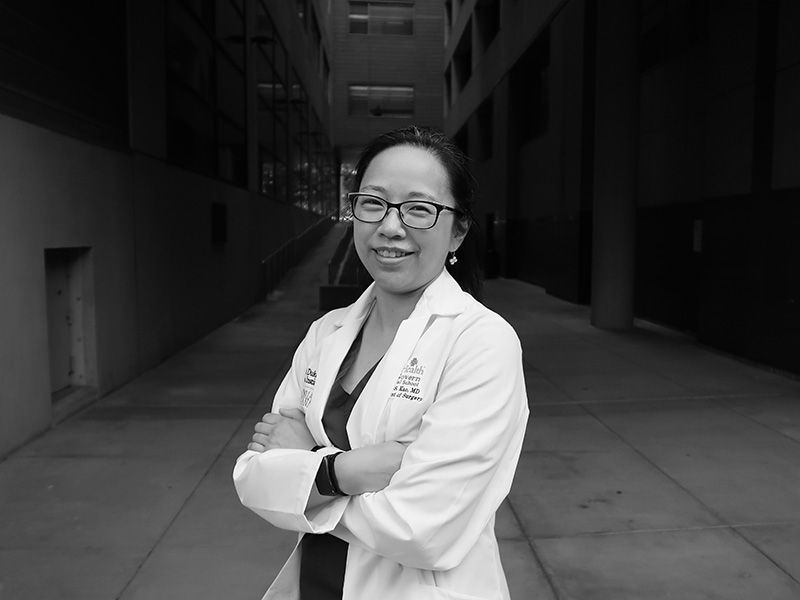Lillian Kao, MD

Professor of Surgery
Jack H. Mayfield, M.D. Chair in Surgery
Director, Division of Acute Care Surgery
Rocks exposed to high temperatures and pressures can be changed to form a different rock, or metamorphic rock; turns out that any type of rock can be modified by the processes of metamorphism.
The pandemic and the social injustices that were at the forefront of the news last year both created extreme pressures that have helped to bring about metamorphosis.
Research – Pre-pandemic, we had been already moving toward the idea of a learning health care system, which allows for rapid continuous learning and innovation informed by research and practice. We have had to learn to rapidly generate evidence to inform the care of COVID patients (and of non-COVID patients given changes in which patients are seeking and receiving health care during the pandemic). For example, I was part of a multi-center trial comparing antibiotics to surgery for acute appendicitis. The trial was completed close to the beginning of 2020, and the follow-up was shortened in order to be able to publish the results to inform the care of patients with appendicitis – many of whom were being treated with antibiotics (due to less operating room availability, due to fears of undergoing surgery during COVID, due to desire not to spend time in the hospital, etc). I am part of another multi-center trial (that Bela Patel and Laura Moore are the site investigators for) whereby stem cells were being used to treat Acute Respiratory Distress Syndrome; the trial quickly shifted to enrolling a large proportion of patients with COVID pneumonia in order to gain evidence about a potential therapy. This is not just happening at UTHealth. Recent articles have cited the faster adoption of universal remote consent, telemedical monitoring, use of novel and more efficient study designs (adaptive designs), etc. in order to overcome enrollment barriers during COVID. Hopefully, this ability to make research more efficient to promote rapid learning will stick around.
Education – Much of education has shifted to online, virtual, distance learning. In addition, many students and residents have had changes in their exposure to different rotations (i.e., medicine residents have spent more time than usual in the ICU in order to care for COVID patients). We are still learning how to optimize virtual learning – I think that attendance is up, but engagement is down. We still need to better learn how to engage learners virtually. Additionally, we have had to shift how we evaluate trainees – rather than a time-based (i.e., resident spends 4 weeks exposed to a specific subspecialty) or volume- based (i.e., resident performs X number of a type of case) approach, we really need to shift toward competency-based assessments. Again, this trend was already happening, but now we are going to have to pivot faster.
Practice – Treating injured patients has been especially challenging during COVID. There has been an uptick in all trauma patients, particularly penetrating (i.e., due to gunshot wounds or stabs, etc). Whereas other surgical services have cut down operations during the beginning and peaks of COVID, the trauma service has had to ramp up person-power. Unlike primary care, which can incorporate telemedicine into their practice more easily, trauma care occurs at the bedside and requires a hands-on approach. We have had to learn to be more efficient – luckily we were in our new tower at Memorial Hermann-Texas Medical Center that has a hybrid operating room that allows us to simultaneously do vascular and interventional radiology procedures and general surgical procedures. We have had to work much more closely as interdisciplinary teams to be good stewards of limited resources (like operating rooms and blood products) to maximize efficiency and to optimize patient care. We have had more communication than ever before between teams to facilitate problem-solving. We have been lucky not to have had to have people change clinical care roles – i.e., we have enough critical care capacity that non-intensivists do not need to manage ventilators.
In summary, I think that overall, change has been positive. The pandemic and other events of the last year have shown that people will rise to the occasion – that through teamwork and collaboration, we can overcome challenges. Additionally, we have seen both individuals and institutions exhibit remarkable resilience and agility.
“The pandemic and the social injustices that were at the forefront of the news last year both created extreme pressures that have helped to bring about metamorphosis.”
